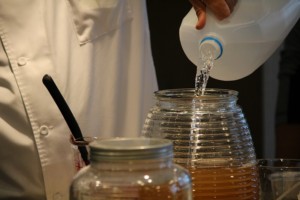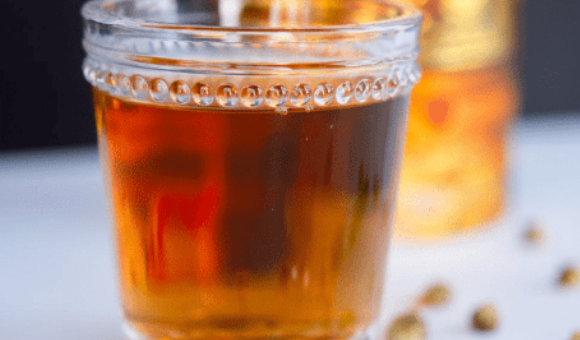Kombucha, a fermented tea with a long list of possible health benefits, has rapidly become a popular beverage choice. U.S. commercial sales of kombucha started in 1995 with one company. According to speakers at the 5th annual KombuchaKon conference held in February 2018 in Long Beach, California, U.S. retail sales of kombucha and other fermented beverages increased 37.4% to $556 million in 2017. Originally available only in organic food stores, kombucha is now widely available in grocery stores and convenience stores, and many people brew kombucha themselves at home. As more people become aware of the health benefits of probiotics, fermented foods and beverages, including kombucha, are increasingly popular.
What is kombucha?
Kombucha is made by fermenting tea, usually black tea but green tea can also be used, with a combination of bacteria and yeast known as a SCOBY (symbiotic culture of bacteria and yeast), and sugar.
It’s believed that kombucha originated in China over 2000 years ago. The name is derived from the Japanese words “seaweed” (kombu) and “tea” (cha).
Kombucha fermentation is a two-part process. First, the yeast converts sugar into ethanol and carbon dioxide, and then the bacteria convert the ethanol into organic acids. As kombucha ferments, the flavor changes from fruity and sour to vinegary. The longer it’s brewed, the tarter the flavor becomes. Because it’s fermented, kombucha contains carbon dioxide which makes it a sparkling, fizzy beverage and produces an alcohol content of <0.5%.
According to the U.S. Treasury, Alcohol and Tobacco Tax and Trade Bureau (TTB), if the alcohol content of kombucha is 0.5% or more alcohol by volume at any time during production, when bottled, or at any time after bottling, the kombucha is an alcoholic beverage and is subject to TTB regulations.
Kombucha can also be pasteurized at 180°F (82°C) for 15 seconds in order to disable the yeasts and prevent them from fermenting further and producing more alcohol. Preservatives such as potassium sorbate and sodium benzoate can also be used to inhibit further fermentation.
What are the possible health benefits?
Kombucha contains live bacteria and yeast, organic acids, B vitamins, antioxidants and trace amounts of minerals. Unflavored kombucha typically contains about 30 calories, 2-3 grams of sugar, and small amounts of caffeine per 8-ounce serving. Kombucha contains no fat or cholesterol. Adding fruit juice or other types of flavoring will change the calorie and nutrient content.
The health benefits of kombucha are thought to be due to the probiotics it contains. Probiotics are live bacteria in fermented foods such as yogurt, kimchi, sauerkraut, and kombucha that are beneficial for our digestive health. Results from animal studies show possible health benefits for our immune system, cardiovascular system, arthritis, and digestion, although more research is needed.
Possible negative side effects
The most commonly-reported negative side effects from drinking kombucha include allergic reactions, jaundice, nausea, vomiting, and head and neck pain. According to the Food and Drug Administration, 4 ounces of kombucha per day is safe for most people, although anyone with a compromised immune function, pregnant or lactating women, young children, or people with preexisting health conditions should avoid drinking kombucha due to the potential for foodborne illness. It’s important to remember that kombucha contains small amounts of alcohol.
How to brew your own kombucha
 Many people prefer to brew their own kombucha at home. By doing this, not only can you control the flavor, you can also save money. Laura McCann, MS, RD, LD and author of the bilingual blog My Family Fork at http://www.myfamilyfork.com/ calculated the cost of her home-brewed kombucha at $.38 per bottle, compared to around $3-$5 per bottle for purchased kombucha.
Many people prefer to brew their own kombucha at home. By doing this, not only can you control the flavor, you can also save money. Laura McCann, MS, RD, LD and author of the bilingual blog My Family Fork at http://www.myfamilyfork.com/ calculated the cost of her home-brewed kombucha at $.38 per bottle, compared to around $3-$5 per bottle for purchased kombucha.
Stefanie Dove, RDN, SNS of Ashburn, VA, uses this simple list of ingredients and equipment to brew kombucha at home:
- Large rubber band
- Coffee filter or cheesecloth
- Black and/or green tea
- Sugar
- SCOBY – Make your own, get some from a friend who brews kombucha, or purchase some. Kate Bloxsom RD, LD, CLT at livewellrd.com notes that each time you brew kombucha, the SCOBY grows, so once you make your first batch, you’ll be set with SCOBY for future batches of kombucha.
- Brewed kombucha, to use as part of the starter for your first batch
- Large mason jar (any size from pint or quart to gallon, depending on how much you want to brew)
- Coffee filters or clean cheesecloth
- 8-16 oz glass bottles with secure lids to store your kombucha
McCann shares this recipe that she has used weekly for the past 12 years:
Ingredients:
- 6 tea bags or 6 teaspoons loose leaf black tea
- 1 ¼ cups sugar
- SCOBY
- 1.5 cups brewed kombucha
Directions:
- Carefully wash all equipment in hot soapy water and then sterilize in hot water.
- Boil 4 cups of water and add to a 1-gallon glass jar.
- Dissolve the sugar in the hot water.
- Add the tea to the sugar water and allow to steep for 5-10 minutes. Remove the tea from the jar.
- Add cool water to the brewed tea, leaving about 2 inches of space at the top of the jar. Cool until the mixture reaches room temperature.
- Add the SCOBY and 1.5 cups kombucha to the jar.
- Cover the jar with a piece of cheesecloth or a couple of coffee filters, and secure tightly with a rubber band.
- Place the covered jar away from direct sunlight in a warm area of your house, about 75-80°. The kitchen pantry is a great spot. Let it sit undisturbed for two weeks.
- After two weeks, remove the SCOBY and 1.5 cups of liquid from the jar and place in a second clean and sterilized jar to use for your next batch of kombucha.
- Fill clean, sterilized glass bottles with your brewed kombucha to within ½” of the top. Tightly secure the top of the bottle, and let it sit on the kitchen counter for 5 days out of direct sunlight to build carbonation.
- Store your kombucha in the fridge and enjoy!
You can enjoy kombucha plain, or flavor it with fresh fruit, fruit puree, 100% fruit juice, or herbs. Bloxsom likes using cranberry, pear, hibiscus, or ginger for flavorings.
Food safety for home-brewed kombucha
Food safety when brewing kombucha at home is critical to avoid contamination with bacteria or toxic mold. All three home kombucha brewers recommend washing your hands and all equipment with hot water and soap before starting to brew kombucha. Sterilize all utensils and glass jars in boiling water to kill any bacteria. Make sure to secure the coffee filter or cheesecloth securely to the top of the jar so that dust or mites aren’t able to get into the kombucha.
Here’s our take on kombucha: Fermented foods and beverages such as kombucha can be helpful parts of an overall healthful diet. Due to the low alcohol and added sugar in kombucha, enjoy it in small amounts and continue to make plain water your primary beverage.
By Lynn Grieger, RDN, CDE, CPT, CHWC
Copyright foodandhealth.com, reprinted with permission.

